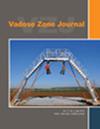Measuring and modeling soil moisture and runoff at solar farms using a disconnected impervious surface approach
IF 2.8
3区 地球科学
Q3 ENVIRONMENTAL SCIENCES
引用次数: 0
Abstract
Ground-mounted photovoltaic sites are often treated as impervious surfaces in stormwater permits. This ignores the pervious soils beneath and between solar arrays and leads to an overestimation of runoff. Our objective was to improve solar farm stormwater hydrology models by explicitly considering the disconnected impervious nature of solar design and site characteristics. Experimental sites established on utility scale solar farms in Colorado, Georgia, Minnesota, New York, and Oregon had perennial vegetative plantings with mean precipitation ranging from 40.6 to 124.5 cm, and soil texture ranging from loamy sand to clay. Soil moisture measurements were collected beneath arrays, under drip edges, and in the vegetated area between arrays at each site. Hydrus-3D models for soil moisture and stormwater hydrology were developed that accounted for precipitation falling on solar panels, drip edge redistribution of rainfall, infiltration, and runoff in the pervious areas between solar arrays and beneath panels. Drip edge runoff averaged 3- to 10-times incident precipitation at the New York and Minnesota sites, respectively. Root mean square error values between measured sub-hourly soil moisture and predicted moisture for large measured single storm events averaged 0.029 across all five sites. Predicted runoff depths were strongly affected by precipitation depth, soil texture, soil profile depth, and soil bulk density. Runoff depths across the five experimental sites averaged 13%, 25%, and 45% of the 2-, 10-, and 100-year design storm depths, clearly showing that these solar farms do not behave like impervious surfaces, but rather as disconnected impervious surfaces with substantial infiltration of runoff in the vegetated areas between and beneath solar arrays.采用断开不透水表面的方法测量太阳能农场的土壤湿度和径流并建立模型
在暴雨许可中,地面光伏场地通常被视为不透水表面。这忽略了太阳能电池阵列下方和之间的透水土壤,导致对径流的高估。我们的目标是通过明确考虑太阳能设计的不透水性质和场地特征,改进太阳能发电场暴雨水文模型。在科罗拉多州、佐治亚州、明尼苏达州、纽约州和俄勒冈州的公用事业规模太阳能发电场建立的实验场地种植了多年生植被,平均降水量从 40.6 厘米到 124.5 厘米不等,土壤质地从壤土到粘土不等。土壤水分测量是在每个地点的阵列下方、滴水边缘和阵列之间的植被区进行的。开发了土壤水分和暴雨水文 Hydrus-3D 模型,该模型考虑了太阳能电池板上的降水、滴水边缘的降雨再分布、渗透以及太阳能电池阵列之间和电池板下方透水区域的径流。纽约州和明尼苏达州的滴边径流平均值分别是入射降水量的 3 到 10 倍。在所有五个地点,对于单次大暴雨事件,每小时测得的土壤湿度与预测湿度之间的均方根误差值平均为 0.029。预测的径流深度受降水深度、土壤质地、土壤剖面深度和土壤容重的影响很大。五个实验点的径流深度平均为 2 年、10 年和 100 年设计暴雨深度的 13%、25% 和 45%,这清楚地表明这些太阳能发电场并不表现为不透水表面,而是表现为断开的不透水表面,径流在太阳能电池阵列之间和下方的植被区大量渗透。
本文章由计算机程序翻译,如有差异,请以英文原文为准。
求助全文
约1分钟内获得全文
求助全文
来源期刊

Vadose Zone Journal
环境科学-环境科学
CiteScore
5.60
自引率
7.10%
发文量
61
审稿时长
3.8 months
期刊介绍:
Vadose Zone Journal is a unique publication outlet for interdisciplinary research and assessment of the vadose zone, the portion of the Critical Zone that comprises the Earth’s critical living surface down to groundwater. It is a peer-reviewed, international journal publishing reviews, original research, and special sections across a wide range of disciplines. Vadose Zone Journal reports fundamental and applied research from disciplinary and multidisciplinary investigations, including assessment and policy analyses, of the mostly unsaturated zone between the soil surface and the groundwater table. The goal is to disseminate information to facilitate science-based decision-making and sustainable management of the vadose zone. Examples of topic areas suitable for VZJ are variably saturated fluid flow, heat and solute transport in granular and fractured media, flow processes in the capillary fringe at or near the water table, water table management, regional and global climate change impacts on the vadose zone, carbon sequestration, design and performance of waste disposal facilities, long-term stewardship of contaminated sites in the vadose zone, biogeochemical transformation processes, microbial processes in shallow and deep formations, bioremediation, and the fate and transport of radionuclides, inorganic and organic chemicals, colloids, viruses, and microorganisms. Articles in VZJ also address yet-to-be-resolved issues, such as how to quantify heterogeneity of subsurface processes and properties, and how to couple physical, chemical, and biological processes across a range of spatial scales from the molecular to the global.
 求助内容:
求助内容: 应助结果提醒方式:
应助结果提醒方式:


